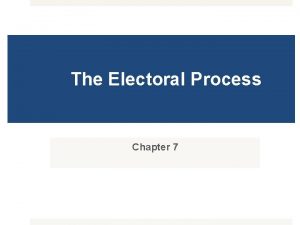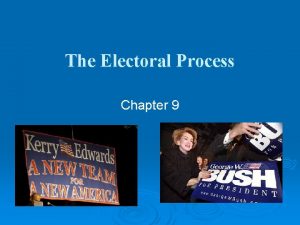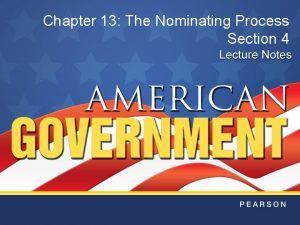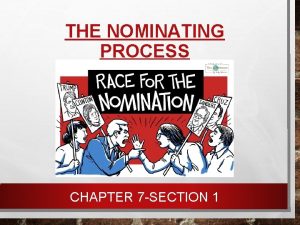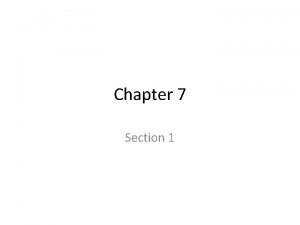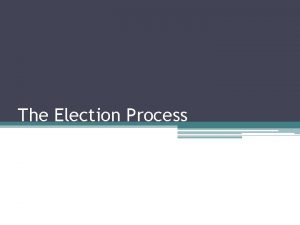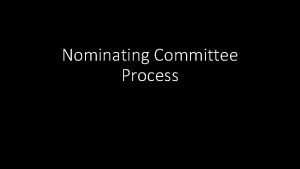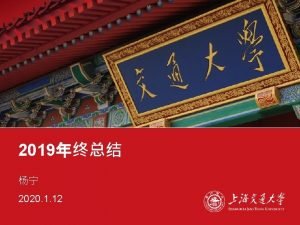CHAPTER 7 SECTION 1 THE NOMINATING PROCESS PAGE












- Slides: 12

CHAPTER 7 SECTION 1 “THE NOMINATING PROCESS” PAGE 184 -192

A CRITICAL FIRST STEP • Nomination of Candidates (all levels of government) • Voters usually choose between 2 candidates (one Republican, one Democrat) • General Election • 5 ways Nominations are made

SELF-ANNOUNCEMENT • Simply declares he/she are running for office • Frequently used in small towns/rural areas • Failed to get party’s nomination or unhappy with candidate party chose • Write-in candidate

THE CAUCUS • Use to be a private meeting • Political parties opened up membership to more people • Today: a caucus is used to make local nomination in some places such as New England. • Open to all members of the party

THE CONVENTION • Convention took place of the caucus method • 1831: Anti-Masons held the first national convention to nominate a presidential candidate and the National Republican (Whig) Party also held a convention • Beings at local level, county convention, then to state convention then to the national convention. • National Convention (President & Vice-President candidates are chosen)

• Party bosses began unfairly influencing delegates • 1910 s: direct primary replaced the convention • Democrats and Republicans hold large conventions every 4 years.

THE DIRECT PRIMARY • An election within a political party to choose the party’s candidates for the next election. • Every state uses this method • Closed Primary: a party’s nominating election in which only party members can vote. • Open Primary: a party’s nominating election in which any qualified voter can vote. (only used in 26 states) • Blanket Primary: “Wide-open primary” every voter received the same ballot that listed every candidate (was used in 3 states) • Supreme Court ruled it was unconstitutional in 2000

THE CLOSED PRIMARY AND THE OPEN PRIMARY • Closed primaries: • Positives: are more fair, and make candidates more responsive to voters, and require voters to give more though to their choices • Criticisms: violates a voter’s privacy because voters must make their party preference known in order to vote. Independents excluded from process • Open primaries: • Supporters: protect privacy, & Independent voters are included in open primaries and are part of nomination process

THE RUNOFF PRIMARY, • Used in 8 states • Candidates must win not just the most votes, but an absolute majority of the votes to win the primary. • Used when no candidate receives a clear majority. • The two top vote getters run against each other. Winner becomes party’s nominee

THE PARTISAN PRIMARY, THE PRESIDENTIAL PRIMARY • Nonpartisan election • • used in most states for electing school and city officers Candidates not identified by a party Clear majority, run unopposed in general election. Ex: Judges and state judges • Presidential primary • The way a party selects its delegates to the national convention

EVALUATION OF THE PRIMARY • Most do not understand the facts • Dislike over having to declare party preference to vote in a primary • Disagree on excluding independent voters • Voters object to not being able to support candidates in more than one party • Idea that the primary is unimportant, • Lower voter turnout

PETITION • Often used a local level • Candidates nominated by gathering signatures from a certain number of qualified voters in their district. • Used for school, city offices, judges, and minor party and independent candidates • Different from state to state • Higher office more signatures needed
 Chapter 7 section 1 the nominating process
Chapter 7 section 1 the nominating process Title in apa format
Title in apa format Chapter 10 section 1: meiosis
Chapter 10 section 1: meiosis Hình ảnh bộ gõ cơ thể búng tay
Hình ảnh bộ gõ cơ thể búng tay Frameset trong html5
Frameset trong html5 Bổ thể
Bổ thể Tỉ lệ cơ thể trẻ em
Tỉ lệ cơ thể trẻ em Chó sói
Chó sói Chụp tư thế worms-breton
Chụp tư thế worms-breton Hát lên người ơi
Hát lên người ơi Các môn thể thao bắt đầu bằng tiếng đua
Các môn thể thao bắt đầu bằng tiếng đua Thế nào là hệ số cao nhất
Thế nào là hệ số cao nhất Các châu lục và đại dương trên thế giới
Các châu lục và đại dương trên thế giới















